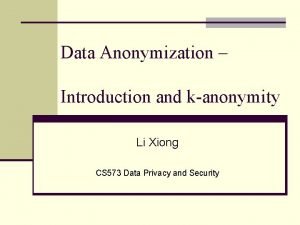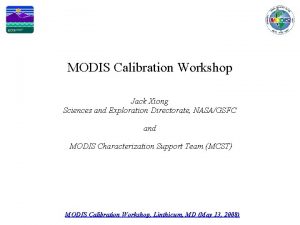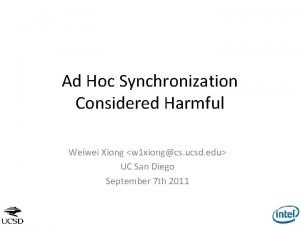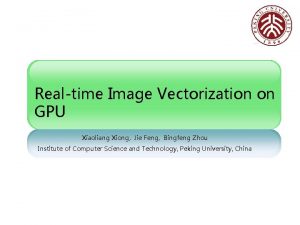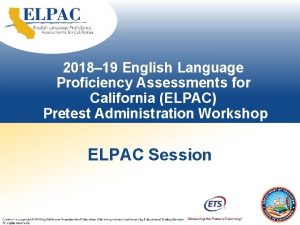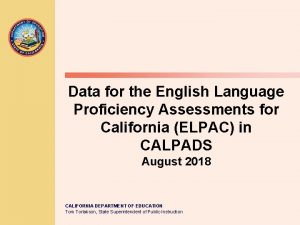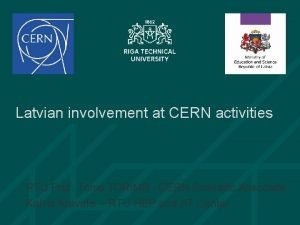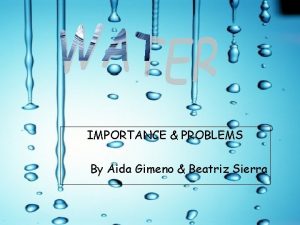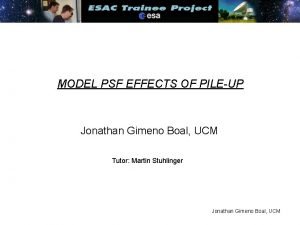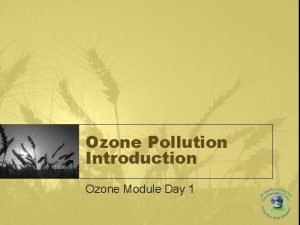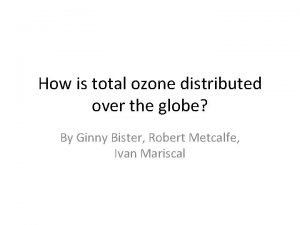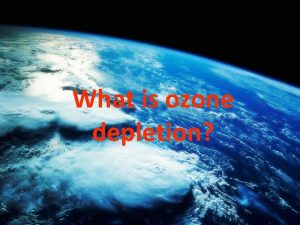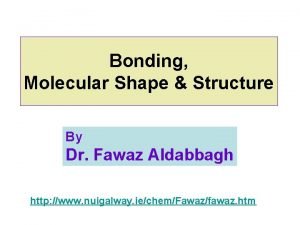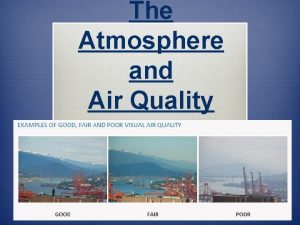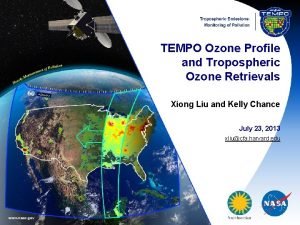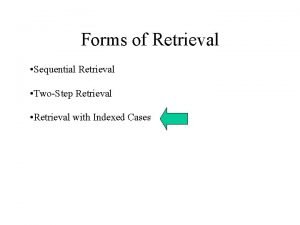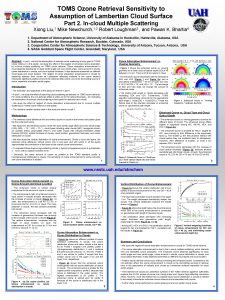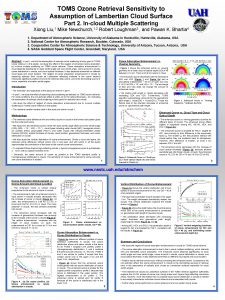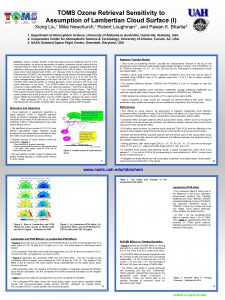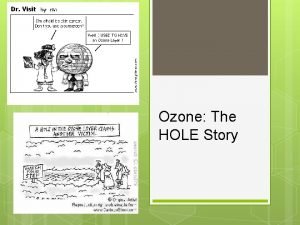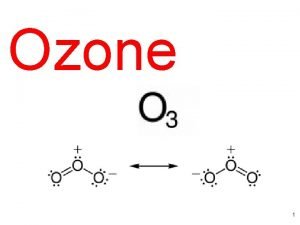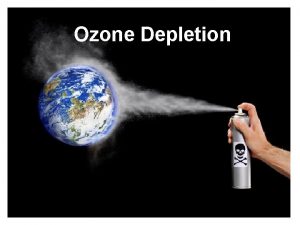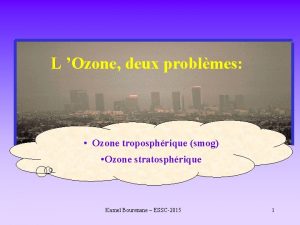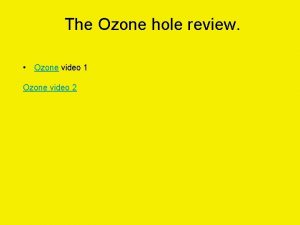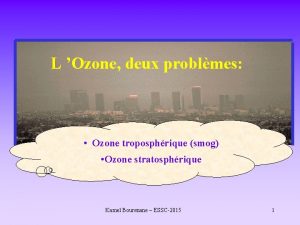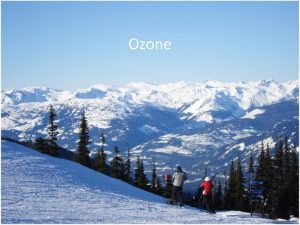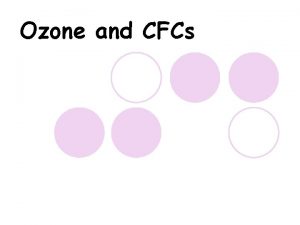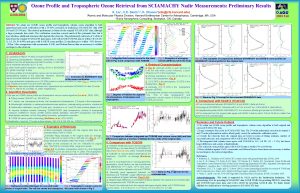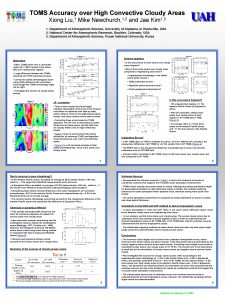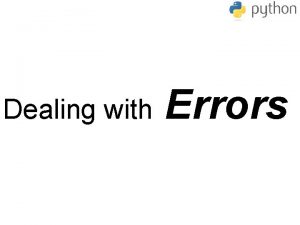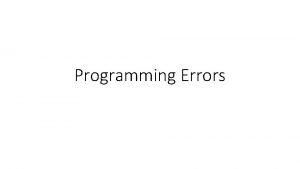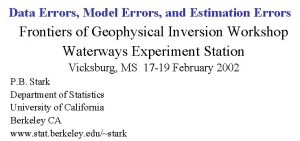TOMS Ozone Retrieval Errors Associated with Clouds Xiong





























- Slides: 29

TOMS Ozone Retrieval Errors Associated with Clouds Xiong Liu, Mike Newchurch Department of Atmospheric Science University of Alabama in Huntsville, Alabama, USA xliu@nsstc. uah. edu, mike@nsstc. uah. edu Robert Loughman Cooperative Center for Atmospheric Science & Technology University of Arizona, Tucson, Arizona, USA Pawan K. Bhartia NASA Goddard Space Flight Center, Greenbelt, Maryland, USA April 18 -19, 2002

Outline n n Motivation Cloud Treatment in the TOMS Operational Algorithm and Potential Ozone Retrieval Errors n Methodology n Results and Discussion n Summary and Conclusions 2

Motivation n Driven by deriving accurate tropospheric ozone from TOMS data. u CCD [Ziemke et al. , 1998] and CCP [Newchurch et al. , 2001] derive tropospheric ozone from TOMS cloudy/clear ozone difference. u Accurate ozone retrieval over cloudy areas is critical to tropospheric ozone derivation. Significant TOMS total ozone excesses of 10 -15 DU are found over tropical high-reflectivity clouds compared to neighboring clear-sky observations. Approximately 4 -9 DU ozone excesses over cloudy scenes remain unexplained [Newchurch et al. , 2001]. The presence of clouds complicates satellite/ground retrieval of ozone as well as other atmospheric components. 3

Cloud Treatment in the TOMS V 7 Algorithm n Opaque Lambertian cloudy surfaces. n Cloud-top pressure (Pc) from monthly mean ISCCP. n n Lambertian-equivalent reflectivity derived from 380 -nm (or 360 -nm) radiance (Imeas). If Imeas Ic, calc(Rc = 80%, Pc) then Full Cloudy If Imeas Ig, calc(Rg = 8%, Pg) then Clear Sky Otherwise, partial cloudy. Determine cloud fraction using the pixel independent approximation. Adding climatological ozone below clouds to complete the total ozone column. 4

Potential Ozone Retrieval Errors Associated with Clouds 5

Methodologies n n n Use Polarized Plane-parallel Gauss-Seidel Radiative Transfer Code [Herman et al. , 1980] forward radiance calculation at six N 7 TOMS channels (312, 317, 331, 339, 360, and 380 nm). PPGSRAD treats clouds as scattering medium. Use the TOMS V 7 algorithm for ozone retrieval. The difference between the retrieved ozone and the forward input ozone indicates ozone retrieval errors. Ozone profiles, ozone absorption and rayleigh scattering coefficients, and other settings are the same between PPGSRAD and TOMRAD (TOMSV 7 forward model). The radiance difference is within 0. 2% on average for clear sky. The corresponding retrieved ozone difference is 0. 6 DU on average. Clouds are assumed horizontally and vertically homogeneous. Typically, a cloud of optical thickness 40 at 2 -12 km is used as a base case to represent tropical-high reflecting clouds. Optical properties are calculated using Mie code for water clouds and Ray tracing code for hexagon column ice crystals and polycrystals. Viewing geometry: u Solar zenith angle o: 0°, 15°, 30°, 45°, 60°, 75°; u Satellite view zenith angle : 0° to 70° every 5°; u Relative Azimuthal Angle : 0° to 180° every 30° 6

Methodologies Separate different effects on ozone retrieval n Lambertian Assumption (Lambertian effect) u u. Partial Cloud Model (PCM effect) In-cloud Ozone Absorption Enhancement (ICOAEN effect) u Below-cloud Ozone Absorption (BCOA effect) u 7

Lambertian and PCM Effects n Dependent on o, , and . Error in total ozone ranges from -4. 1 to 4. 4 DU. Avg. = 0. 7 1. 1 DU. n Large error in ozone above cloud occurs at small effective cloud fraction. n 8

Lambertian and PCM Effects Positive errors in ozone above clouds and negative errors in ozone below clouds tend to cancel each other. n Modify the TOMSV 7 algorithm to force the effective cloud fraction to be 1 to obtain the Lambertian effect. n Lambertian effect: -4. 1 --- 4. 4 DU The error in ozone below clouds is almost 0 except at large viewing geometry due to the profile difference between forward calculation and retrieval. n PCM effect: present in both errors in ozone above and below clouds. n 9

Lambertian and PCM Effects WCHG WC HEX PCM and Lambertian effects vary with phase function n Average Ozone Retrieval Error: -0. 8 --- 1. 4 DU POLY n 10

Lambertian and PCM Effects 11

In-Cloud Ozone Absorption Enhancement A priori 20. 8 DU in cloud in the forward calculation. n Large errors (effective ozone) at small solar zenith angle and view zenith angles. About 19 DU at nadir. n Azimuthally independent. n 12

In-Cloud Ozone Absorption Enhancement Excellent comparison indicates that TOMSV 7 retrieves almost all the ozone absorption of reflected radiation in clouds. n Using the triplet methods cannot reduce the errors, because the path enhancement are almost the same at all the channels. n 13

In-Cloud Ozone Absorption Enhancement Photon Path Length decreases with increasing o and . TOMSV 7 takes the geometrical path length into account. The effective ozone in the cloud decreases more with increasing geometrical path. n n Solar zenith angle and view zenith angle are exchangeable. 14

In-Cloud Ozone Absorption Enhancement ICOAEN Effect vs. Cloud Optical Properties Slight variation among different cloud types. n WCHG > WC > HEX > POLY n 15

In-Cloud Ozone Absorption Enhancement ICOAEN Effect vs. Cloud Optical Thickness Generally, ICOAEN effect decreases with increasing optical thickness. n The increase of ICOAEN effect with optical thickness at smaller optical thickness is due to the imperfect retrieval efficiency at smaller surface reflectivity. n 16

In-Cloud Ozone Absorption Enhancement ICOAEN Effect vs. In-Cloud Ozone ICOAEN effect is largely dependent on the amount of ozone in the cloud. The ratio of retrieved to actual ozone in cloud slightly decreases with increasing ozone in the cloud. n 17

In-Cloud Ozone Absorption Enhancement ICOAEN Effect vs. Cloud Altitude The ratio of retrieved O 3 to actual O 3 in the cloud slightly increases with increasing cloud altitude. n 18

In-Cloud Ozone Absorption Enhancement ICOAEN Effect vs. Ozone Distribution in Clouds 1. Original (20. 8 DU) 2. Well-mixed (20. 8 DU) 3. Homogeneous (20. 8 DU) 4. Linearly increasing (20. 8 DU) 5. Linearly decreasing (20. 8 DU) 6. Upper 2 km (4. 2 DU) 7. Lower 2 km (4. 2 DU) ICOAEN is very dependent on ozone distribution in clouds. n Ozone distributed in the upper part of cloud usually contributes more to ozone absorption in clouds. n 19

In-Cloud Ozone Absorption Enhancement Vertical Distribution of ICOAEN Effect For upward radiance, ozone absorption peaks in the upper part of clouds. The height of the peak increases with increasing viewing geometry. n For downward radiance, ozone absorption peaks in the middle of the clouds and almost symmetric around the peak location. n 20

In-Cloud Ozone Absorption Enhancement Vertical Distribution of ICOAEN Effect vs. Cloud Optical Depth and Cloud Optical Properties E-folding depth is defined as the depth above which 1/e 36. 8% of ozone absorption occurs. n The larger the cloud optical thickness, the smaller the Efolding depth; the larger the asymmetry factor, the larger the depth. n 21

Below-Cloud Ozone Absorption Ozone absorption below clouds depends on the cloud optical thickness and the amount of ozone below clouds n 22

Ozone Retrieval Error Associated with Clouds n Comparison of ozone retrieval for two cases: u fc = 1, consistent with forward calculation u TOMSV 7 partial cloud model At smaller cloud optical thickness, using the partial cloud model gives the about correct result due to the compensating errors. n 23

Ozone Retrieval Error Associated with Clouds At larger cloud optical thickness, these two methods start to converge because the effective cloud fraction is either 1 or very close to 1. n Part of the in-cloud ozone can be seen by TOMS and retrieved. However, both methods add almost all the ozone below clouds, leading to positive errors. n 24

Ozone Retrieval Error Associated with Clouds For a cloud of optical thickness of 1 at 2 -3 km or 11 -12 km, using the TOMSV 7 partial-cloud model leads to the about correct retrieved ozone. n Assuming the full-cloud minimum reflectivity as 100% gives almost the same result as 80% (i. e. the TOMSV 7 partial-cloud model) due to the compensating errors. n 25

Ozone Retrieval Error Associated with Partial Clouds n Pixel-independent approximation: n Error is approximately proportional to cloud fraction. In Cloud Ozone Absorption Enhancement Lambertian and PCM effects tauc = 1 tauc = 40 26

Ozone Retrieval Error Associated with Partial Clouds At smaller cloud optical thickness, using the TOMS partial cloud model retrieves the about correct results for different forward cloud fractions. n The good result occurs because of the compensating errors so that the positive error due to ozone absorption in clouds and the negative error due to using the partial-cloud model almost cancel. n 27

Summary and Conclusions The assumption of Lambertian cloud surface is good in ozone retrieval for cloud optical thickness 20, with average ozone retrieval errors within 3 DU. n Ozone retrieval error due to using the partial-cloud model is usually negative if the derived effective cloud fraction is < 1 , and the magnitude increases with decreasing cloud optical thickness due primarily to the cloud fraction being underestimated and with less ozone added below clouds. n Because the TOMS instrument can see ozone absorption in and below clouds, the algorithm assumption of a Opaque cloudy surface results in positive errors. Ozone absorption in clouds is largely dependent on ozone distribution in clouds, ozone amount in clouds, and geometrical path length, cloud thickness, and slightly dependent on cloud optical properties and cloud optical thickness. n At small cloud optical thickness, using the partial-cloud model leads to the about correct total ozone due to the compensating errors. The negative errors due to using the partial-cloud model tend to cancel the positive errors due to ozone absorption in and below clouds. n With increasing cloud optical thickness, positive errors due to ozone absorption in and below clouds slowly decrease in magnitude, while negative errors due to using the partial cloud model decrease more dramatically, leading to increasing positive errors. n 28

29
 Li xiong
Li xiong Nadsvd
Nadsvd Unforgettable journey
Unforgettable journey Weiwei xiong
Weiwei xiong Hmong shaman rituals
Hmong shaman rituals Alonzo harlow israel
Alonzo harlow israel Xiong jie
Xiong jie Vong xiong
Vong xiong Sala de congresos valencia
Sala de congresos valencia Was nick excited to meet myrtle
Was nick excited to meet myrtle Toms gimeno
Toms gimeno Santo toms
Santo toms Torims
Torims Toms grīnfelds
Toms grīnfelds Language image
Language image Toms elpac
Toms elpac Toms rostoks
Toms rostoks Toms torims
Toms torims Toms parents
Toms parents Brand
Brand What is osmosis in biology
What is osmosis in biology Santotoms
Santotoms Toms gimeno
Toms gimeno Protective ozone layer
Protective ozone layer Ozone blanket
Ozone blanket Ozone layer levels
Ozone layer levels How is total ozone distributed over the globe
How is total ozone distributed over the globe Protection of ozone layer
Protection of ozone layer O3 molecular geometry
O3 molecular geometry Sulphur oxide
Sulphur oxide
